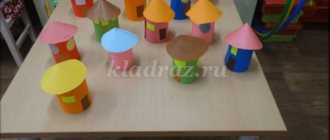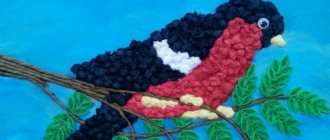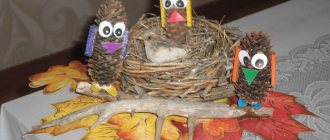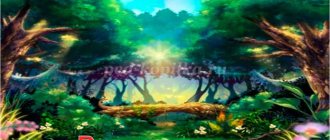Small children experience the world by touch. Application helps to embody the images and objects seen on paper or using other materials. For small children, paper dishes using the appliqué technique will be a good opportunity to learn the names of objects. And adult children hone their skills of believability in crafts.
It can be made from paper, fabric and plasticine. Tableware applique is most often simple and almost all of its types are suitable for preschoolers and kindergarteners. And having supplemented the basic craft with his own elements, the child will take the craft to school.
Glasses in applique
Offer to make your child a refreshing glass of lemonade. Cut out the glass. The lemon circles will be made from circles and triangles of colored paper. Ice cubes are made from soaked thin napkins. Add a straw and the craft is ready.
You can make a summer cocktail using a colored paper coffee cup. Cut it in half lengthwise and stick it on cardboard. Garnish with a citrus slice (umbrella). Decorate the background as desired.
Positive aspects of creating applications
This type of crafts has a very beneficial effect on the development of the child. The main advantages of creating applications:
- Development of fine motor skills of the hands;
- Development of creative and logical thinking;
- Trains perseverance and accuracy;
- While working, the baby remembers what objects look like and what they are called.
Also, in this way, a child can create not just a simple standard craft, but also present the work as a gift or interior decor.
Cups and teapots
Using the cutout appliqué technique, create dishes for children's tea parties. If the product is made of white sheet, then it is decorated with paints or felt-tip pens, and scrapbooking paper will immediately make a beautiful cup.
Cut out the stencil and fold it in half. The dotted lines are the fold locations. Glue it together and the cup is ready.
They also make tea sets.
The composition of buttons looks no less interesting. It is important to choose a color scheme so that the work is not too colorful.
For the next creation you need an openwork napkin (it can be cut out), colored paper, cardboard, paints, scissors and glue.
We glue an openwork napkin onto the cardboard. A cup is cut out on top. Decorate randomly. Draw or cut out white steam. We complement the tea party with candy. You can create a cup from the cover of a magazine or newspaper, or special gift packaging.
For your attention – a teapot made of fabric.
Simply cut out the thin fabric and glue it onto the cardboard. The centers of flowers can be buttons or beads.
Summary of a lesson on application on the topic “Dishes” in kindergarten
- April 2, 2021
International and All-Russian competitions
Laureate of the All-Russian competition of pedagogical excellence “Methodological piggy bank of a kindergarten teacher”
Summary of a lesson in the second junior group of kindergarten on the topic “Utensils.”
Goal: To reinforce the names of utensils with children.
Tasks:
- Develop memory, attention, speech of children.
- Activate the dictionary on the topic: “Dishes”.
- Develop the ability to coordinate words in a sentence.
- To develop skills of cultural communication, hospitality, and friendliness.
GCD move
Educator: Guys, hello.
(There is a knock on the door. Winnie the Pooh enters the group and cries).
Educator: Good afternoon, Winnie the Pooh. What's happened? Why are you crying?
Winnie the Pooh. Good afternoon guys. How can I not cry? Today is my birthday. Eeyore, Piglet, Owl and Rabbit will come to visit me in the evening, and I have completely forgotten how to greet guests. Also, I don’t have any mugs in my house, because I broke the last mug this morning.
Educator: Winnie the Pooh, don’t be upset. The guys and I will definitely help you. Really, guys?
Children: Yes.
Educator: Guys, who knows what they usually treat guests to at birthday parties?
Children: Tea, sweets, cake, fruit.
Educator: Well done. Guys, let's show Winnie the Pooh how to properly set the table.
Children: First you need to cover the table with a beautiful tablecloth (demonstration). Then you should put the sugar bowl. It contains sugar. And this is a napkin holder. Napkins are placed in it to wipe your hands. And this is a candy bowl. You need to put candy in it.
Educator: That's right, but fruits can be put in a vase like this. It will look beautiful on the table. Guys, where will Winnie the Pooh put the cake?
Children: The cake can be placed on this spread.
Educator: Everything is correct. And for tea you need teaspoons (demonstrates), a teapot and mugs.
Guys, let's play a little with Winnie the Pooh.
Fizminutka
(Children form a circle. The teacher is in the center of the circle, reads the text and shows the movements that the children repeat) Knock - knock - knock, knock - knock - knock. (They knock their fists against each other.) A loud knocking sound is heard. A loud chime is heard. (They stomp their feet, hands on the belt). Ding-ding - dong, ding - ding - dong. It is in the kitchen that spoons, forks, cups, and ladle are dancing. (Tilt left and right arms with a shelf in front of the chest). Tra-ta-ta, tra-ta-ta All the dishes started dancing! (Perform a “spring”, hands on the belt). Kettle lid here, there! Spoons in a cup - knock, knock! And the pots - boom - boom! Frying pans - don - don! (“Dance”, alternately putting the left and right leg forward on the heel, hands behind the back). That's how the dance is - beauty! Tra-ta-ta, tra-ta-ta! (Clap their hands.)
Educator: Guys, did you like playing?
Children: Yes.
Winnie the Pooh: And I really liked it.
Educator: Guys, now I propose to make multi-colored mugs for Winnie the Pooh and his guests.
Children go to the tables. In front of each of them lies a ready-made mug made of colored cardboard. There are multi-colored circles on a plate. Children take a circle, smear it with a glue stick and place it on the circle in any order. Each child must glue 3 to 5 circles. The teacher and Winnie the Pooh help the children when they have difficulty.
At the end of the work, Winnie the Pooh and the teacher praise the children. Each child says what color his mug is and what color he pasted the circles (if the child has difficulty, other children help).
The teacher invites the children to give their mugs to Winnie the Pooh. Children are happy to give. Winnie the Pooh says “Thank you” and gives the children balloons. Children congratulate Winnie the Pooh on his birthday and sing “Loaf” to him. Winnie the Pooh says goodbye and leaves.
Educator:
- Guys, who came to visit us today?
- What happened to Winnie the Pooh?
- How did we help him?
- How did we congratulate the bear cub? What did he give us?
- What did you like most?
The work was presented by teacher Maria Aleksandrovna Druzhkova.
For the little ones
You can start making your first applications from about 2 years old, you just have to choose the easiest and simplest options. As a rule, appliques of vegetables and fruits in a preparatory group or nursery are done in the form of a single work, rather than a composition.
This way it is easier for children to glue them and also to remember them. To make it as easy as possible for your child, you can use already prepared templates of fruits and vegetables for appliqué.
Cherry
Cherry is an excellent applique option for the youngest children on this topic. To make it you will need:
- white sheet of cardboard;
- pencil;
- scissors;
- glue;
- colored markers;
- red colored paper.
Work plan:
- Draw 2 small circles on colored paper and cut them out.
- Glue the circles onto the cardboard so that they are on the same level and not far from each other.
- Using a brown felt-tip pen, draw 2 stripes, connecting the circles to create a design in the form of a pair of cherries.
- Draw a leaf with a green felt-tip pen.
A pineapple
Almost every child likes this exotic fruit, and of course it makes them want to portray it. For a more beautiful and interesting look, you can make it voluminous from simple colored paper. All you need for this craft:
- yellow, green paper;
- sheet of cardboard;
- glue;
- scissors;
- pencil.
Step-by-step work plan:
- Draw a pineapple on a piece of cardboard.
- Cut the yellow paper into strips, approximately 5 cm long and 1.5-2 cm wide.
- Take one strip and fasten its ends to make a ring, glue the ends together.
- Press down a small part of the ring a little and glue it to the upper contour of the pineapple.
- Glue another ring next to it and fill the entire top row.
- Take a ring of paper and also glue it, but just below the top row of the pineapple, while the glued part should be under the free edge of the upper rings.
- Follow the previous step until the entire pineapple is filled.
- Cut out small long leaves from green paper and glue them to the top of the pineapple.
Fruit basket
Quite an interesting way to create a fruit applique from felt. This material is sold in a wide range of colors and is easy to work with. Also for this craft you will need: a sheet of cardboard, brown paper, scissors, a glue gun and sticks for it, a pencil, a newspaper.
Action plan.
- Draw a basket on a sheet of cardboard.
- Cut the sheets of paper into strips about 2 cm wide and roll them into thin tubes, seal the edges well.
- Lay out the outline of the basket from newspaper tubes, cutting them to the desired size.
- Tear the brown paper into small pieces and roll them into tight balls.
- Glue the balls over the entire area of the basket, so that there is no gap between them.
- Cut out the desired fruits from felt, attach them to the basket in a happy order and glue them.
In principle, for such a volumetric application of fruits and vegetables, you can use seeds and cereals, as well as eggshells.
Applications depicting fruits and berries allow you to create colorful works from a variety of materials and using different techniques. Even the smallest creative hands can begin their acquaintance with appliques with vegetables, berries, fruits, and older children can create entire compositions.
Applications fruits and vegetables
Applications in the form of fruits and vegetables are quite popular; they are created by both younger and older children. Using them you can glue real compositions, and from different materials.
The depiction of fruits and vegetables using the appliqué technique facilitates their quick learning and memorization, which is very important for a small child.
Materials for their manufacture
To make applications depicting fruits and berries, you can use not only the usual material - colored paper, but also others:
- corrugated paper;
- felt;
- some types of fabrics;
- dried tree leaves and berries;
- seeds;
- cereals and pasta;
- beads;
- eggshells;
- threads
An application on this topic with several types of materials turns out to be quite interesting and original.
Technicians
As a rule, fruits and vegetables are depicted in the form of standard applications, but they also look very interesting in 3D volume. If desired, you can make the applique using the origami technique or by twisting narrow strips of paper.
They also often do work using the mosaic technique, that is, they tear paper or break eggshells into small pieces, and then fill them with the required image.






